Climatic Factors in Beechnut Regeneration: From Seed Quality to Germination
Abstract
1. Introduction
2. Results
3. Discussion
4. Materials and Methods
4.1. Study Area
4.2. Sampling Protocol and Mother Mexican Beech Selection
4.3. Beechnut Sample Collection
Beechnut Germination
4.4. Relationship Among Beechnut Classification and Microenvironmental Factors
5. Conclusions
Author Contributions
Funding
Data Availability Statement
Acknowledgments
Conflicts of Interest
Abbreviations
| TMCF | Tropical Montane Cloud Forest |
References
- Williams-Linera, G. El Bosque de Niebla Del Centro de Veracruz: Ecologia, Historia y Destino En Tiempos de Fragmentacion y Cambio Climatico; Instituto de Ecología A.C.: Xalapa, Mexico, 2012; ISBN 9707091010. [Google Scholar]
- Rahbek, C.; Borregaard, M.K.; Antonelli, A.; Colwell, R.K.; Holt, B.G.; Nogues-Bravo, D.; Rasmussen, C.M.Ø.; Richardson, K.; Rosing, M.T.; Whittaker, R.J.; et al. Building Mountain Biodiversity: Geological and Evolutionary Processes. Science 2019, 365, 1114–1119. [Google Scholar] [CrossRef] [PubMed]
- Peters, R. Architecture and Development of Mexican Beech Forest. In Vegetation Science in Forestry; Box, E.O., Ed.; Kluwer Academic Publishers: Dordrecht, The Netherlands; Boston, MA, USA; London, UK, 1995; pp. 325–343. [Google Scholar]
- Alvarez-Aquino, C.; Williams-Linera, G. Seedling Bank Dynamics of Fagus grandifolia var. mexicana before and after a Mast Year in a Mexican Cloud Forest. J. Veg. Sci. 2002, 13, 179–184. [Google Scholar] [CrossRef]
- Rodríguez-Ramírez, E.C.; Martínez-Falcón, A.P.; Luna-Vega, I. Spatial Patterns of Mexican Beech Seedlings (Fagus grandifolia subsp. mexicana (Martínez) A.E. Murray): Influence of Canopy Openness and Conspecific Trees on Recruitment Mechanisms. Ann. For. Sci. 2018, 75, 27. [Google Scholar] [CrossRef]
- Godínez-Ibarra, O.; Ángeles-Pérez, G.; López-Mata, L.; García-Moya, E.; Valdez-Hernández, J.I.; de Los Santos-Posadas, H.; Trinidad-Santos, A. Seed Rain and Seedling Emergence of Fagus grandifolia subsp. mexicana at La Mojonera, Hidalgo, Mexico. Rev. Mex. Biodivers. 2007, 78, 117–128. [Google Scholar]
- Rodríguez-Ramírez, E.C.; Sánchez-González, A.; Ángeles-Pérez, G. Current Distribution and Coverage of Mexican Beech Forests Fagus grandifolia subsp. mexicana. Mexico. Endanger. Species Res. 2013, 20, 205–216. [Google Scholar] [CrossRef]
- Rodríguez-Ramírez, E.C.; Sánchez-González, A.; Ángeles-Pérez, G. Relationship between Vegetation Structure and Microenvironment in Fagus grandifolia subsp. mexicana Forest Relicts in Mexico. J. Plant Ecol. 2016, 11, 237–247. [Google Scholar] [CrossRef]
- Cleavitt, N.L.; Fairbairn, M.; Fahey, T.J. Growth and Survivorship of American Beech (Fagus grandifolia Ehrh.) Seedlings in a Northern Hardwood Forest Following a Mast Event. J. Torrey Bot. Soc. 2008, 135, 328–345. [Google Scholar] [CrossRef]
- Hiroki, S.; Matsubara, T. Fluctuation of Nut Production and Seedling Appearance of a Japanese Beech (Fagus crenata Blume). Ecol. Res. 1995, 10, 161–169. [Google Scholar] [CrossRef]
- Nasiri, N.; Marvie Mohadjer, M.R.; Etemad, V.; Sefidi, K.; Mohammadi, L.; Gharehaghaji, M. Natural Regeneration of Oriental Beech (Fagus orientalis Lipsky) Trees in Canopy Gaps and under Closed Canopy in a Forest in Northern Iran. J. For. Res. 2018, 29, 1075–1081. [Google Scholar] [CrossRef]
- Vacchiano, G.; Hacket-Pain, A.; Turco, M.; Motta, R.; Maringer, J.; Conedera, M.; Drobyshev, I.; Ascoli, D. Spatial Patterns and Broad-Scale Weather Cues of Beech Mast Seeding in Europe. New Phytol. 2017, 215, 595–608. [Google Scholar] [CrossRef] [PubMed]
- Holmes, R.L. Computer-Assisted Quality Control in Tree-Ring Dating and Measurement. Tree-Ring Bull. 1983, 43, 69–78. [Google Scholar]
- Cook, E.R.; Holmes, R.L. Guide for Computer Program ARSTAN. In The International Tree-Ring Data Bank Program Library Version 2.0 User’s Manual; Grissino-Mayer, H.D., Holmes, R.L., Fritts, H.C., Eds.; Laboratory of Tree-Ring Research: Tucson, AZ, USA, 1996; pp. 75–87. [Google Scholar]
- Burns, K.C. Masting in a Temperate Tree: Evidence for Environmental Prediction? Austral Ecol. 2012, 37, 175–182. [Google Scholar] [CrossRef]
- Peltier, A.; Touzet, M.-C.; Armengaud, C.; Ponge, J.-F. Establishment of Fagus Sylvatica and Fraxinus Excelsior in an Old-Growth Beech Forest. J. Veg. Sci. 1997, 8, 13–20. [Google Scholar] [CrossRef]
- Cleavitt, N.L.; Fahey, T.J. Seed Production of Sugar Maple and American Beech in Northern Hardwood Forests, New Hampshire, USA. Can. J. For. Res. 2017, 47, 985–990. [Google Scholar] [CrossRef]
- Shibata, M.; Tanaka, H.; Iida, S.; Abe, S.; Masaki, T.; Niiyama, K.; Nakashizuka, T. Synchronized Annual Seed Production by 16 Principal Tree Species in a Temperate Deciduous Forest, Japan. Ecology 2002, 83, 1727–1742. [Google Scholar] [CrossRef]
- Cao, K.-F.; Peters, R.; Oldeman, R.A.A. Climatic Ranges and Distribution of Chinese Fagus Species. J. Veg. Sci. 1995, 6, 317–324. [Google Scholar] [CrossRef]
- Peters, R. Ecology of Beech Forests in the Northern Hemisphere. Ph.D. Thesis, Wageningen Agricultural University, Wageningen, The Netherlands, 1992. [Google Scholar]
- Alonso-Crespo, I.M.; Silla, F.; Jiménez del Nogal, P.; Fernández, M.J.; Martínez-Ruiz, C.; Fernández-Santos, B. Effect of the Mother Tree Age and Acorn Weight in the Regenerative Characteristics of Quercus faginea. Eur. J. For. Res. 2020, 139, 513–523. [Google Scholar] [CrossRef]
- Kalemba, E.M.; Bagniewska-Zadworna, A.; Suszka, J.; Pukacka, S. Dehydration Sensitivity at the Early Seedling Establishment Stages of the European Beech (Fagus sylvatica L.). Forests 2019, 10, 900. [Google Scholar] [CrossRef]
- Gorzelak, M.A.; Asay, A.K.; Pickles, B.J.; Simard, S.W. Inter-Plant Communication through Mycorrhizal Networks Mediates Complex Adaptive Behaviour in Plant Communities. AoB Plants 2015, 7, plv050. [Google Scholar] [CrossRef] [PubMed]
- Hilton, G.M.; Packham, J.R. Variation in the Masting of Common Beech (Fagus sylvatica L.) in Northern Europe over Two Centuries (1800–2001). Forestry 2003, 76, 319–328. [Google Scholar] [CrossRef]
- Etemad, V.; Sefidi, K. Seed Production and Masting Behaviour in Oriental Beech (Fagus orientalis Lipsky) Forests of Northern Iran. For. Ideas 2017, 23, 65–76. [Google Scholar]
- Bruijnzeel, L.A.; Scatena, F.N.; Hamilton, L.S. Tropical Montane Cloud Forests: Science for Conservation and Management; Cambridge University Press: Cambridge, UK, 2010. [Google Scholar]
- Collet, C.; Chenost, C. Using Competition and Light Estimates to Predict Diameter and Height Growth of Naturally Regenerated Beech Seedlings Growing under Changing Canopy Conditions. Forestry 2006, 79, 489–502. [Google Scholar] [CrossRef]
- Collet, C.; Lanter, O.; Pardos, M. Effects of Canopy Opening on Height and Diameter Growth in Naturally Regenerated Beech Seedlings. Ann. For. Sci. 2001, 58, 127–134. [Google Scholar] [CrossRef]
- Tavankar, F.; Picchio, R.; Nikooy, M.; Jourgholami, M.; Naghdi, R.; Latterini, F.; Venanzi, R. Soil Natural Recovery Process and Fagus orientalis Lipsky Seedling Growth after Timber Extraction by Wheeled Skidder. Land 2021, 10, 113. [Google Scholar] [CrossRef]
- Abe, M.; Izaki, J.; Miguchi, H.; Masaki, T.; Makita, A.; Nakashizuka, T. The Effects of Sasa and Canopy Gap Formation on Tree Regeneration in an Old Beech Forest. J. Veg. Sci. 2002, 13, 565–574. [Google Scholar] [CrossRef]
- Ohkubo, T. Structure and Dynamics of Japanese Beech (Fagus japonica Maxim.) Stools and Sprouts in the Regeneration of the Natural Forests. Vegetaio 1992, 101, 65–80. [Google Scholar] [CrossRef]
- Awan, S.; Footitt, S.; Finch-Savage, W.E. Interaction of Maternal Environment and Allelic Differences in Seed Vigour Genes Determines Seed Performance in Brassica oleracea. Plant J. 2018, 94, 1098–1108. [Google Scholar] [CrossRef] [PubMed]
- Rodríguez-Ramírez, E.C.; Camacho-Islas, L.; Martínez-Falcón, A.P.; Luna-Vega, I.; Carbó-Ramírez, P. Masting Effect on Alpha and Beta Avian Diversity in Fragmented Forests of Relict-Endangered Mexican Beech (Fagus grandifolia subsp. mexicana). Avian Res. 2021, 12, 49. [Google Scholar] [CrossRef]
- Peel, M.C.; Finlayson, B.L.; McMahon, T.A. Updated World Map of the Köppen-Geiger Climate Classification. Hydrol. Earth Syst. Sci. 2007, 11, 1633–1644. [Google Scholar] [CrossRef]
- FAO. FAO-UNESCO Soil Map of the World; Revised Legend; FAO: Rome, Italy, 1988. [Google Scholar]
- Rodríguez-Ramírez, E.C.; Luna-Vega, I.; Rozas, V. Tree-Ring Research of Mexican Beech (Fagus grandifolia subsp. mexicana) A Relict Tree Endemic to Eastern Mexico. Tree Ring Res. 2018, 74, 94–107. [Google Scholar] [CrossRef]
- Perry, J.N.; Bell, E.D.; Smith, R.H.; Woiwod, I.P. SADIE: Software to Measure and Model Spatial Pattern. Asp. Appl. Biol. 1996, 46, 95–102. [Google Scholar]
- Perry, J.N.; Winder, L.; Holland, J.M.; Alston, R.D. Red-Blue Plots for Detecting Clusters in Count Data. Ecol. Lett. 1999, 2, 106–113. [Google Scholar] [CrossRef]
- Perry, J.N.; Dixon, P.M. A New Method to Measure Spatial Association for Ecological Count Data. Ecoscience 2002, 9, 133–141. [Google Scholar] [CrossRef]
- Balzano, S.; Porzio, G.C.; Salvatore, R.; Vistocco, D. Statistical Learning and Modeling in Data Analysis; Springer: Berlin/Heidelberg, Germany, 2021; ISBN 9783030699437. [Google Scholar]
- Zeileis, A.; Meyer, D.; Hornik, K. Residual-Based Shadings for Visualizing (Conditional) Independence. J. Comput. Graph. Stat. 2007, 16, 507–525. [Google Scholar] [CrossRef]
- Baddeley, A.; Turner, R. Spatstat: An R Package for Analyzing Spatial Point Patterns. J. Stat. Softw. 2005, 12, 1–42. [Google Scholar] [CrossRef]
- Fiala, A.C.S.; Garman, S.L.; Gray, A.N. Comparison of Five Canopy Cover Estimation Techniques in the Western Oregon Cascades. For. Ecol. Manag. 2006, 232, 188–197. [Google Scholar] [CrossRef]
- Borcard, D.; Gillet, F.; Legendre, P. Numerical Ecology with R; Springer: New York, NY, USA, 2011; ISBN 978-1-4419-7975-9. [Google Scholar]
- Legendre, P.; Legendre, L. Numerical Ecology, 2nd ed.; Elsevier Science: Amsterdam, The Netherlands, 1998; ISBN 0444892508. [Google Scholar]
- Oksanen, J.; Blanchet, F.G.; Friendly, M.; Kindt, R.; Legendre, P.; McGlinn, D.; Minchin, P.R.; O’Hara, R.B.; Simpson, G.L.; Solymos, P.; et al. Vegan: Community Ecology Package. R Package Version 2.4-1; CRAN: Durham, NC, USA, 2016; Available online: https://CRAN.R-project.org/package=vegan (accessed on 24 May 2025).
- Peña, L.; Amezaga, I.; Onaindia, M. At Which Spatial Scale Are Plant Species Composition and Diversity Affected in Beech Forests? Ann. For. Sci. 2011, 68, 1351–1362. [Google Scholar] [CrossRef]
- Rodríguez-Ramírez, E.C.; Terrazas, T.; Luna-Vega, I. The Influence of Climate on the Masting Behavior of Mexican Beech: Growth Rings and Xylem Anatomy. Trees 2018, 33, 23–35. [Google Scholar] [CrossRef]
- Ames-Martínez, F.N.; Luna-Vega, I.; Dieringer, G.; Rodríguez-Ramírez, E.C. The Effect of Climate Change on Arcto-Tertiary Mexican Beech Forests: Exploring Their Past, Present, and Future Distribution. Ecol. Evol. 2022, 12, e9228. [Google Scholar] [CrossRef] [PubMed]
- Rodríguez-Ramírez, E.C.; Williams-Linera, G.; Díaz-Ávalos, C.; Luna-Vega, I. Masting Effect on Canopy Greenness and Climate Response on Seed Production of Fagus grandifolia subsp. mexicana across the Sierra Madre Oriental, Mexico. Clim. Chang. Ecol. 2021, 2, 100035. [Google Scholar] [CrossRef]
- Gavranović Markić, A.; Vujnović, Z.; Kičić, M.; Ivanković, M.; Škvorc, Ž.; Bogdan, S.; Oršanić, M. Seed Quantity and Quality Variation in European Beech (Fagus sylvatica L.): A Comparative Analysis of Different Crop Years. South-East Eur. For. 2024, 15, 1–12. [Google Scholar] [CrossRef]
- Nagel, T.A.; Kutsch, W.L.; Oßwald, R.; Skomarkova, M.V.; Sippell, L.; Rennenberg, H. Extreme summer heat and drought lead to early fruit abortion in European beech. Tree Physiol. 2019, 39, 1283–1298. [Google Scholar] [CrossRef]
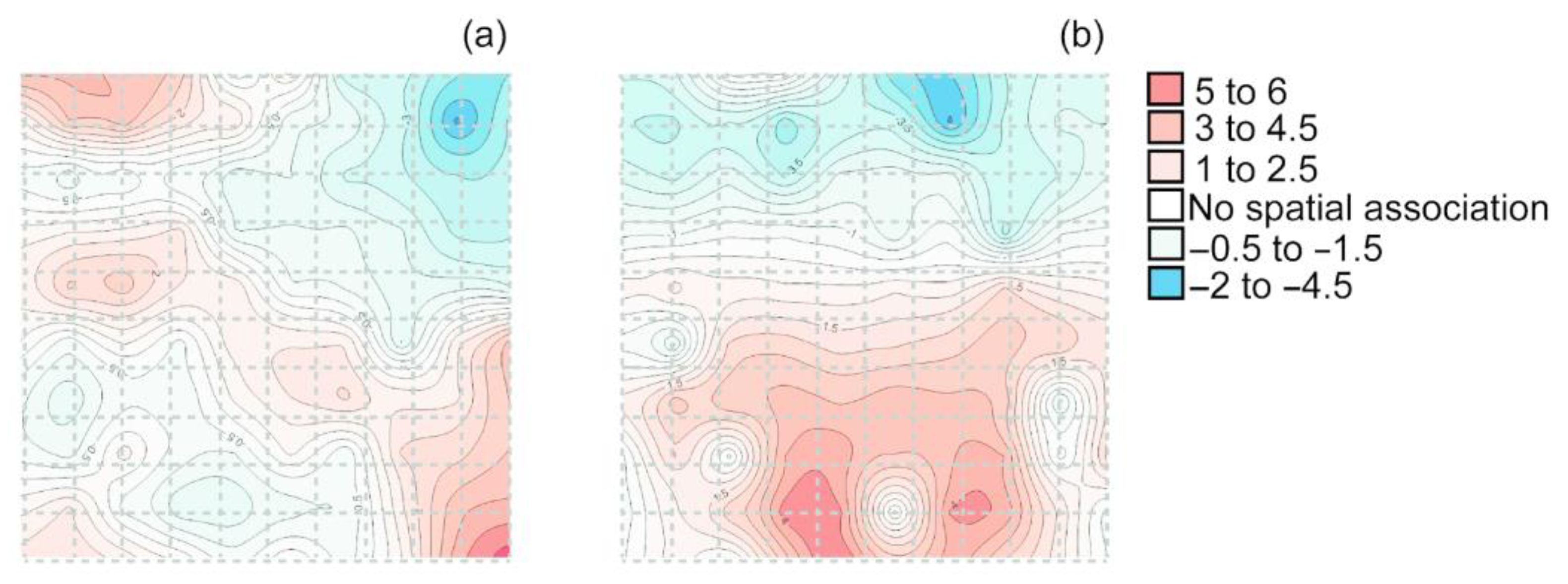
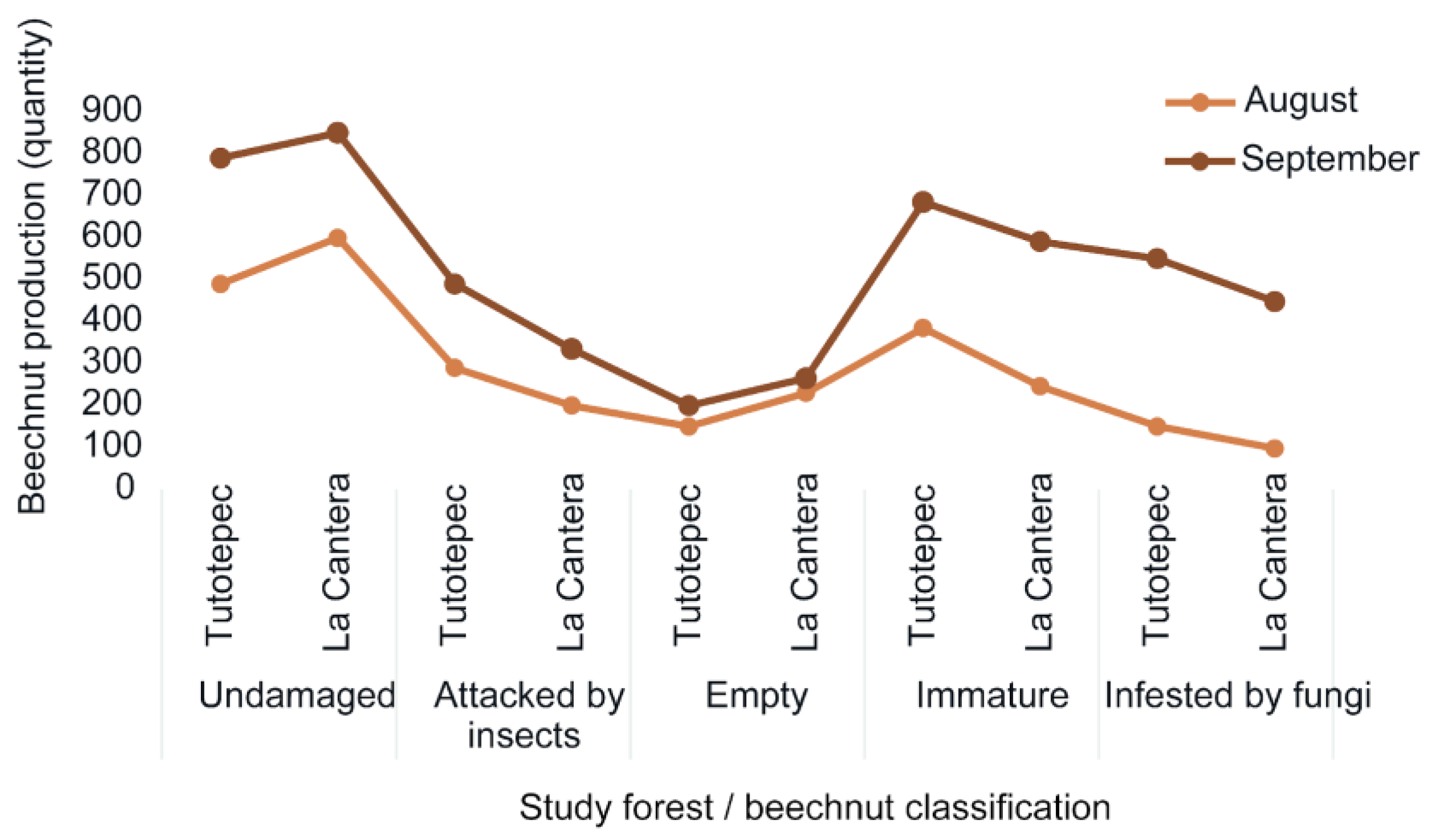
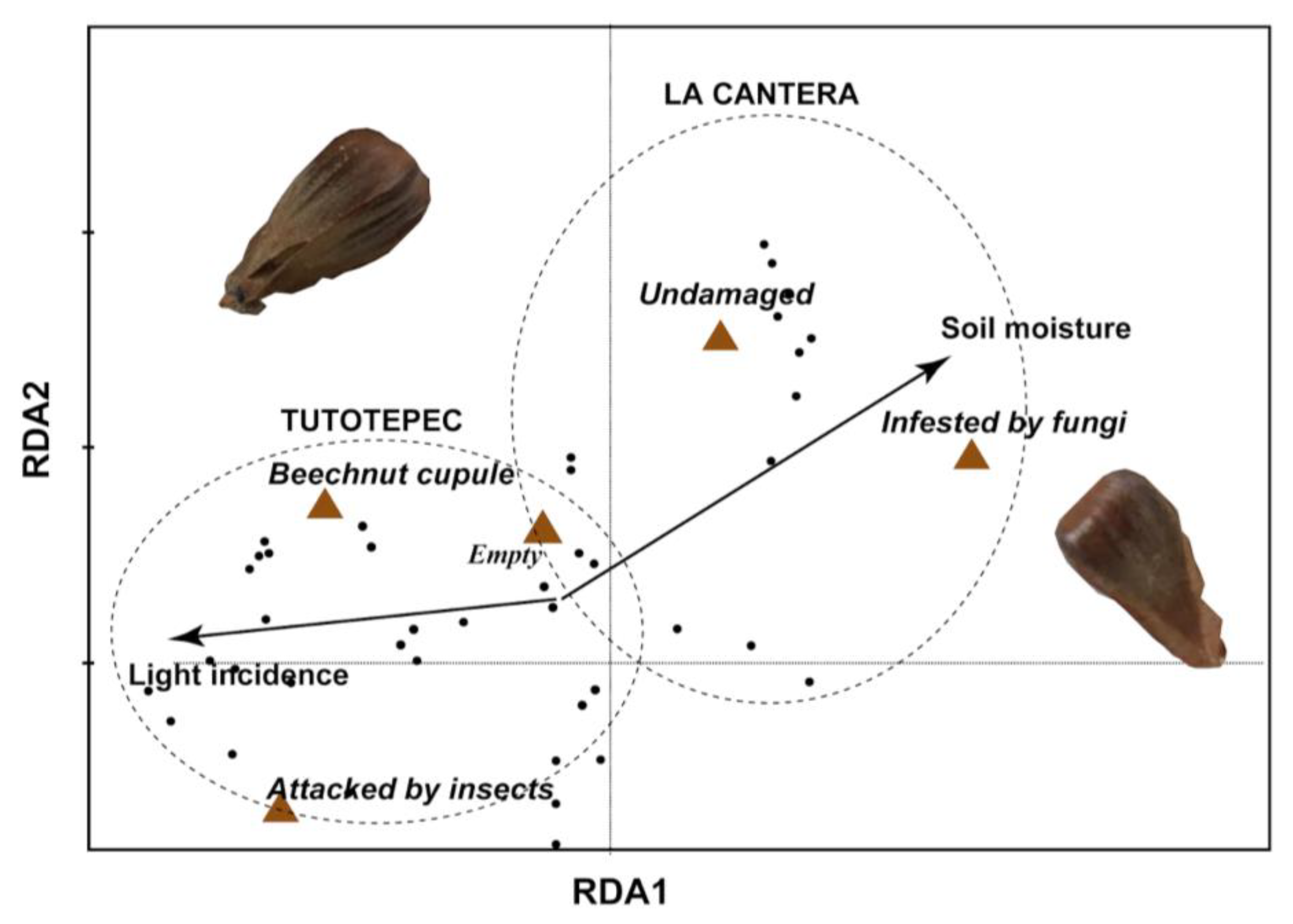
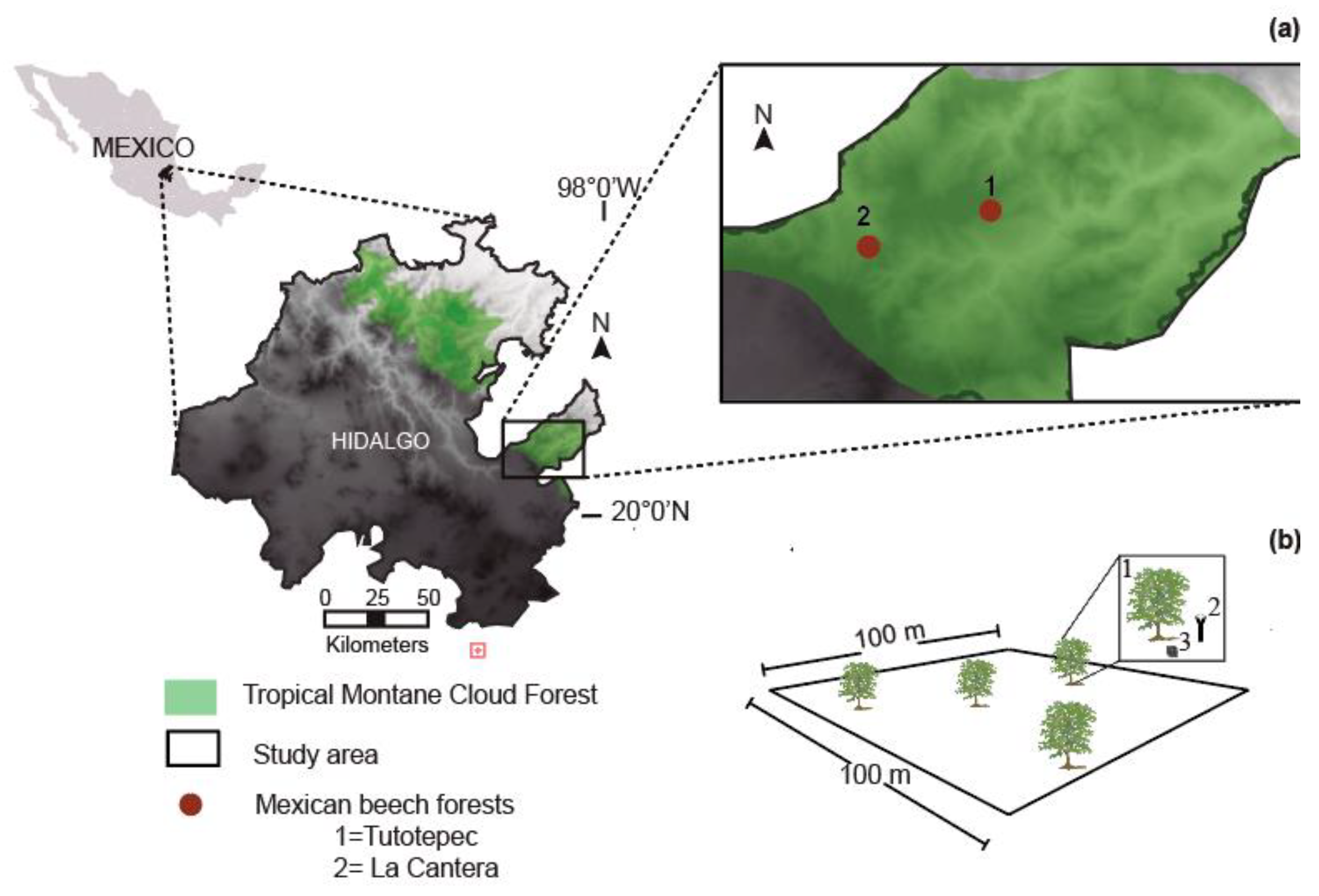
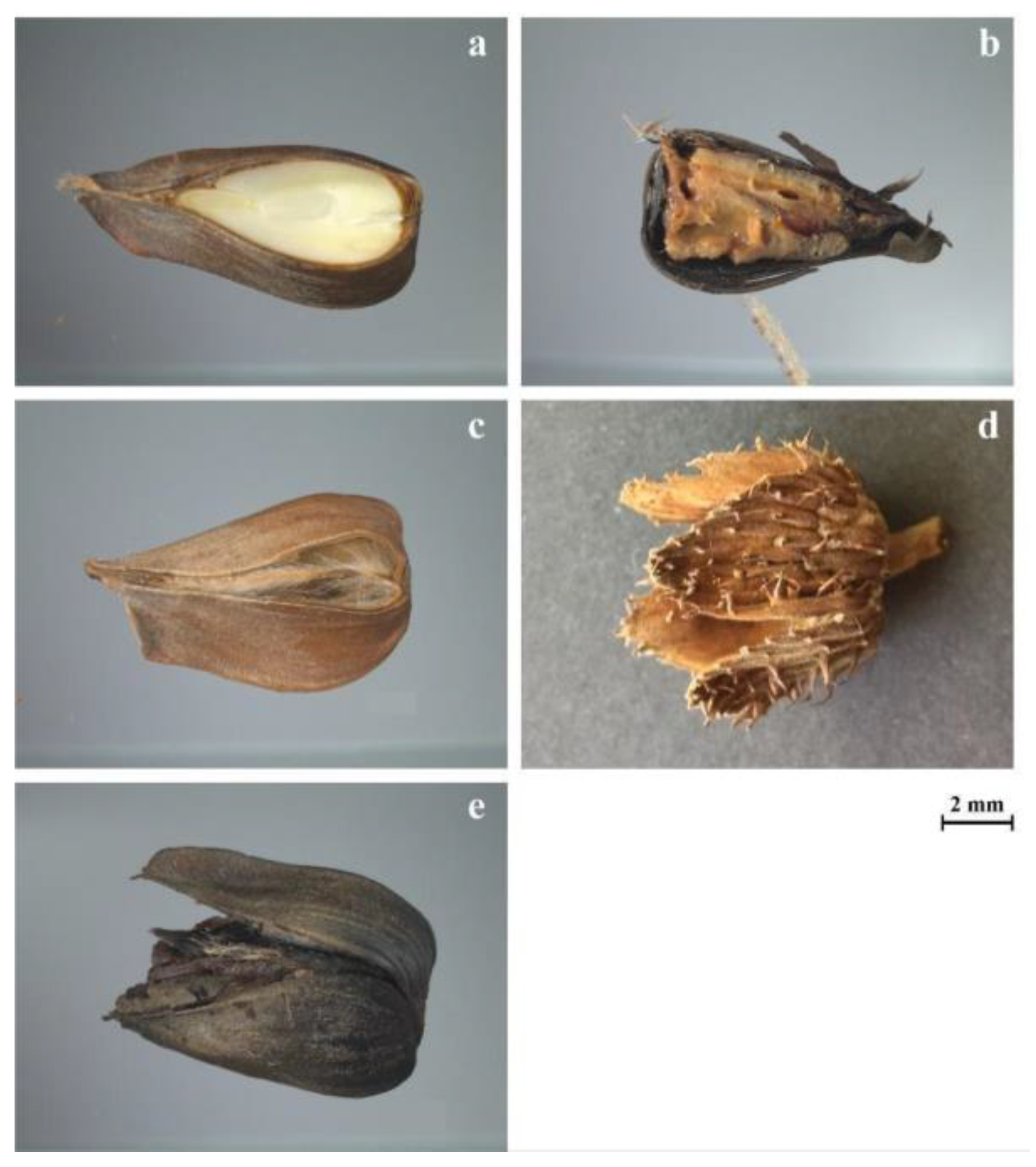
| Statistics | Tutotepec | La Cantera | |
|---|---|---|---|
| Sampled trees | 20 | 20 | |
| Crossdated series a | 28 | 28 | |
| Diameter at breast height (cm) | Max | 110 | 225 |
| Height (m) | Max Min | 28 | 20 |
| 15 | 12 | ||
| Master series (years) | 1899–2019 | 1754–2019 | |
| Crossdated rings a | 2978 | 2647 | |
| False rings | 3 | 6 | |
| Series intercorrelation a | 0.551 | 0.648 | |
| Mean sensitivity (MS) a | 0.283 | 0.316 | |
| Autocorrelation a | 0.648 | 0.497 | |
| Common interval | 1899–2019 | 1949–2019 | |
| Mean/median age (years) b | 1105/119.5 | 96.5/92 | |
| Signal-to-noise ratio c | 15.16 | 18.45 | |
| R-bar | 0.48 | 0.40 | |
| Goodness-of-Fit Criteria | |||||||||||||||
|---|---|---|---|---|---|---|---|---|---|---|---|---|---|---|---|
| Adjustment Criteria | GL | Value | GL/Value | ||||||||||||
| Tutotepec | La Cantera | Tutotepec | La Cantera | Tutotepec | La Cantera | ||||||||||
| Deviation | 82 | 98 | 625.24 | 568.98 | 4.35 | 3.87 | |||||||||
| Pearson’s X2 | 82 | 76 | 612.48 | 698.31 | 5.89 | 4.78 | |||||||||
| Log-maximum likelihood | −183.56 | −167.9 | |||||||||||||
| Estimated parameters | |||||||||||||||
| Parameter | GL | Estimate value | Standard error | 95% range of estimate value | X2 | ||||||||||
| Tutotepec | La Cantera | Tutotepec | La Cantera | Tutotepec | La Cantera | Tutotepec | La Cantera | ||||||||
| β0 | 1 | 0.3564 | 0.457 | 0.642 | 0.7548 | 0.226 | 0.457 | 32.41 | 31.57 | ||||||
| β1 | 1 | 0.6123 | 0.587 | 0.261 | 0.3458 | 1.758 | 2.654 | 30.49 | 29.48 | ||||||
| β2 | 1 | 0.4872 | 0.5987 | 0.164 | 0.458 | −0.124 | −0.512 | 5.74 | 4.98 | ||||||
| β3 | 1 | 0.2897 | 0.348 | 0.101 | 0.458 | −0.554 | −0.702 | 7.68 | 8.97 | ||||||
| β4 | 1 | −0.8751 | 0.7891 | 0.084 | 0.0678 | −0.785 | −0.666 | 8.96 | 9.47 | ||||||
Disclaimer/Publisher’s Note: The statements, opinions and data contained in all publications are solely those of the individual author(s) and contributor(s) and not of MDPI and/or the editor(s). MDPI and/or the editor(s) disclaim responsibility for any injury to people or property resulting from any ideas, methods, instructions or products referred to in the content. |
© 2025 by the authors. Licensee MDPI, Basel, Switzerland. This article is an open access article distributed under the terms and conditions of the Creative Commons Attribution (CC BY) license (https://creativecommons.org/licenses/by/4.0/).
Share and Cite
Rodríguez-Ramírez, E.C.; Argüelles-Marrón, B. Climatic Factors in Beechnut Regeneration: From Seed Quality to Germination. Stresses 2025, 5, 44. https://doi.org/10.3390/stresses5030044
Rodríguez-Ramírez EC, Argüelles-Marrón B. Climatic Factors in Beechnut Regeneration: From Seed Quality to Germination. Stresses. 2025; 5(3):44. https://doi.org/10.3390/stresses5030044
Chicago/Turabian StyleRodríguez-Ramírez, Ernesto C., and Beatriz Argüelles-Marrón. 2025. "Climatic Factors in Beechnut Regeneration: From Seed Quality to Germination" Stresses 5, no. 3: 44. https://doi.org/10.3390/stresses5030044
APA StyleRodríguez-Ramírez, E. C., & Argüelles-Marrón, B. (2025). Climatic Factors in Beechnut Regeneration: From Seed Quality to Germination. Stresses, 5(3), 44. https://doi.org/10.3390/stresses5030044







